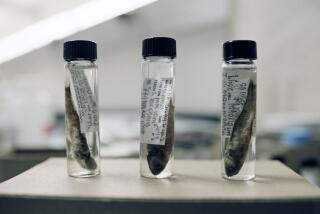Study finds plastic debris and man-made fibers in fish sold in markets
- Share via
Scientists have long suspected that plastic trash eaten by fish, crabs, bivalves and other marine species may be spreading through the food web.
Now, researchers from UC Davis and Hasanuddin University in Indonesia are reporting some of the first findings of plastic debris and textile fibers in the fish on consumer’s dinner plates.
About a quarter of the fish sampled from markets in California and Indonesia contained the man-made debris, according to the study published a month ago in the online journal Scientific Reports.
The researchers also discovered a stark contrast between the types of debris found in fish from both locations. In Indonesia, they found plastic fragments. In California, a majority of the contaminants consisted of fibers from textiles.
The variations in debris types probably reflect differences in local waste management strategies, according to the study.
In Indonesia, 30% of the solid waste generated by humans is discarded directly onto beaches and into rivers and drainage channels, the study said.
In California, there are more than 200 wastewater treatment plants discharging billions of liters of treated effluent just offshore.
“Even though wastewater treatment results in a reduction of many contaminants,” the study said, “synthetic fibers from washing machines can remain in sewage effluent, and may be delivered to aquatic habitats in large concentrations via wastewater outfalls.”
Plastic debris and fibers were found only in fishes’ guts. Therefore, humans are likely to ingest man-made debris only if fish is eaten whole, a common practice in Indonesia.
“I still eat fish -- if it’s sold in the United States,” said Susan Williams, a professor with the UC Davis Bodega Marine Laboratory and co-author of the study. “That’s because we fillet fish and remove their guts, so the likelihood of eating plastic and fibers is very small.”
An estimated 245 million tons of plastic is produced annually around the world, according to industry estimates. That amount represents 70 pounds of plastic annually for each of the 7.1 billion humans on the planet, scientists say.
The study raises concerns about possible effects on human health from a cocktail of hazardous chemicals associated with plastics and some textiles.
“Future risk assessments should consider anthropogenic debris as another factor for seafood safety advisories relevant for consumers,” the study said.
In the study, samples of whole fish, gastrointestinal tracts of fish and whole bivalves were collected during August and November of 2014 from markets and fishermen at Half Moon Bay and Princeton, Calif., and from the Paotere fish market in Makassar, Indonesia.
In California, the researchers processed 64 individual fish across 12 different species. They found man-made fibrous material in 29% of jack smelt, 30% of Pacific anchovies, 33% of yellowtail rockfish, 43% of striped bass, 25% of Chinook salmon, 20% of blue rockfish, 60% of Pacific sand dabs, 9% of lingcod and 33% of Pacific oysters.
The researchers were unable to confirm whether the material was made from synthetic material or natural fibers such as cotton.
Fibers collected that resembled researchers’ laboratory coats or that was the same color of their clothing on the day of analysis were discarded and not counted as man-made debris.
Follow me @LouisSahagun for more fascinating stories







